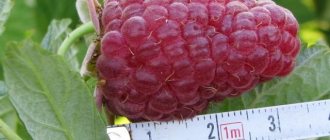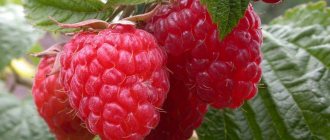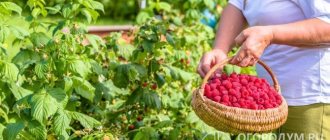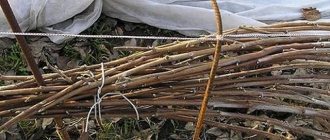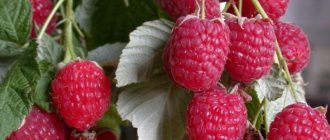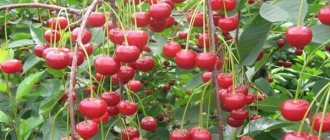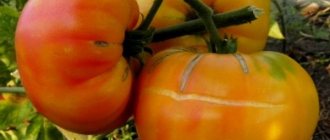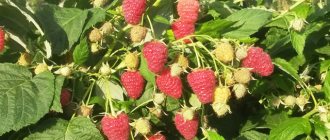In many vegetable gardens and garden plots of Russian summer residents, raspberries have been growing for decades, but do not have the range of advantages of modern varieties. It often gets sick and is seriously damaged by insects, but the owners are in no hurry to part with it: the taste and real “forest” aroma of the berries make up for all the shortcomings. About the history of the appearance of such plants they usually say: “remained from the previous owners”, “crawled from neighbors”, “were bought at a spontaneous market”, etc. In a significant number of cases we are talking about a very specific variety of raspberries - “Kuzmin News”.
Raspberry Novosti Kuzmina (pictured) is traditionally loved by many generations of Russian summer residents
We decided that readers should take a closer look at this “old-timer” of Russian gardens. And let's start by considering the main characteristics of the variety:
| Parameter | Characteristic |
| Culture | Garden raspberry (Rubus idaeus L.) |
| Fruiting | One-time (non-repairable) |
| Ripening time | Early |
| Productivity | Average: 50-70 c/ha; up to 1.5 kg per bush |
| Berries | Medium (weighing 2-2.5 g), oblong or blunt-conical, dark red |
| Pulp | Very tasty, sweet, aromatic |
| Tasting assessment | 5 points (out of 5) |
| Purpose of berries | Dessert, suitable for all types of processing |
| Features of the plant | The bushes are tall (up to 2-2.5 m), spreading. Annual shoots are erect, with a curved top, long internodes, and covered with a strong waxy coating. The spines are thin, purple in color, medium length and hard. The leaves are large, slightly wrinkled |
| Shoot formation activity | Average |
| Sustainability | The variety is highly winter-hardy and hardy. Susceptible to all fungal and viral diseases, pest damage (raspberry gnat and spider mite) |
| Cultivation technology | Agricultural technology is standard. It is recommended to build trellises and tie shoots to supports; sufficient watering is necessary (especially in hot weather and drought) |
| Recommended growing regions | Northern, Northwestern, Central, Volga-Vyatka, Central Black Sea Region, North Caucasus, Middle Volga, Lower Volga, Ural |
| Year of registration in the Federal State Budgetary Institution "State Varietation Commission" | 1947 |
| Originators | Federal State Budgetary Institution "All-Russian Selection and Technological Institute of Horticulture and Nursery Growing" (Moscow) and Federal State Unitary Enterprise "Kotlasskoye" (Arkhangelsk region) |
Description of raspberries News Kuzmina
Kuzmin's news has been known for quite some time, but has not lost its popularity and is in constant demand. This proven variety has proven itself well and is a favorite of many experienced gardeners, despite the emergence of a huge number of new varieties.
News Kuzmin was bred in 1880 in the Nizhny Novgorod region, in the city of Vetluga, by breeder Nikanor Vonifatievich Kuzmin, in whose honor it received its name. The “parents” of this variety are the Russian raspberry Smolenskaya and the American raspberry Kubert.
Raspberries are very tall, reaching a height of 2.5 meters. The shape of the bush may vary depending on the climatic conditions of its growth. In the central and southern regions it is spreading, and in the north it is erect. News Kuzmina almost does not produce root shoots, which makes it easier to care for and complicates reproduction.
The number of replacement shoots is average. With age, the bush's ability to form shoots decreases. Young stems are light green, last year's stems turn brown. The shoots are covered with a waxy coating and a small number of thorns, the bulk of which are located in the lower part. There are small thorns on the lower surface of the leaves (they are slightly curled), which is a distinctive feature of the variety. Raspberry flowers are white, like other varieties, but quite large, which makes the bushes especially attractive.
The berries have long stalks and small seeds. They are colored pinkish-red and have a blunt-conical oblong shape. The fruits are large and medium in size, weighing 2-4 grams. Easily separated from the stalk. After ripening, they do not fall off, but remain hanging on the bush. Ripe berries acquire a pronounced aroma of forest raspberries. In addition, they have a pleasant sweet and sour taste and are considered the standard for taste (their taste is rated 5 points). They are eaten fresh and used to make juice, compote, liqueur, and jam. Despite their excellent taste, the berries are unsuitable for the market, since due to their high juiciness and low density they quickly lose their presentation and become completely untransportable.
The ripening period of raspberries is mid-early. Usually the fruits ripen at the end (and even the middle) of June - early July. But in dry conditions, due to moisture deficiency, the ripening period is delayed by 15-20 days. Fruiting is extended, thanks to which you can enjoy the excellent taste of the berries for two months.
The productivity is quite high. Usually 1.5-2 kilograms of berries are harvested from a bush (50-70 centners per hectare).
Raspberries are self-fertile, but if other varieties are planted next to them, their yield will increase.
Although Novosti Kuzmina does not belong to the remontant varieties, in favorable weather conditions, with frequent summer rains, young shoots can reach 2-3 meters in height and partially bear fruit in the fall.
Novosti Kuzmina is characterized by increased winter hardiness and can withstand 25-degree frosts without problems, even without cover.
Landing
Raspberries are planted in spring or autumn. To plant raspberries, it is recommended to choose a place protected from cold winds, since the plant is very sensitive to drafts. The area should be dug up in advance.
News Kuzmina grows on any soil, but the maximum yield can only be obtained on fertile soil, the acidity of which varies from 5.5 to 6.5. If the soil is too acidic, it can be neutralized with limestone flour, slaked lime or wood ash.
It is better to fertilize the soil with organic matter: humus, manure or humus. Seedlings are planted in pre-prepared holes (30x30 centimeters) or trenches. They are planted in 2 rows, which are placed at a distance of about a meter. Leave a half-meter distance between the bushes. Plants are watered abundantly.
Kuzmin's news needs support due to its height. Therefore, plants are grown on two or three rows of trellises: the bottom row is made at a height of half a meter, and the top row is made at arm’s length.
Care
The variety is characterized by unpretentiousness. Raspberries feel great on any soil, even not too fertile. But the plant does not tolerate drought well, which is why the berries become very small and dry out. Therefore, regular watering is required in dry summers. With sufficient moisture, the berries remain large throughout the entire fruiting period, which is significantly extended.
Trimming
Typically, pruning is done in early spring before sap flow begins or in the fall. But in order to increase productivity and increase its frequency, it is also recommended to prune the bushes after picking the berries.
To increase the number of flowers and achieve uniform ripening, shoots of the first year are pinched at a meter height. This technique activates branching and promotes the formation of fruit branches.
Top dressing
Kuzmin's news can grow without feeding. But in order to get large berries and a good harvest, it is recommended to apply potassium and phosphorus fertilizers during the period of berry formation and ripening.
Agrotechnical features
When planting raspberries, it is necessary to take a responsible approach to choosing the site intended for it. So, in conditions of sufficient moisture, the best option for the crop would be to place it on gentle slopes with warm exposures or flat areas. If we are talking about arid regions, then optimal conditions for the crop can be created on light slopes in northern directions or on flat areas with low relief. Definitely not suitable for planting are depressions where there is excessive humidity and stagnation of cold air, as well as hills where there is no snow left in winter due to the wind blowing it away. Groundwater should lie no closer than 1-1.5 meters to the soil surface.
Pre-planting soil preparation consists of deep loosening it while simultaneously filling it with the necessary fertilizers. The planting itself News Kuzmina can be carried out in early spring or autumn after leaf fall. Sometimes the summer method is also practiced - using green cuttings. The variety can be planted either in individual bushes or in rows. In the latter case, the distance between rows can reach 1.5-2 meters, and between plants in a row - 40-50 cm.
When caring for vegetative raspberries, important operations are weeding, watering, fertilizing and pruning fruit-bearing shoots. They try to keep the soil between the rows free of weeds, since competition for moisture and nutrients will inevitably lead to weakened growth and reduced plant yields. They try to irrigate not too often, but with sufficient volumes of water in order to thoroughly wet the root layer.
Harvesting is carried out at intervals of one or two days, trying to make greater use of the morning and evening time, when there is no sweltering heat. Containers for harvesting raspberries should be small, so that under their own weight, the delicate berries Kuzmin News are less crushed. After the fruiting period of the variety has ended, the shoots from which the fruits have been harvested are cut off with pruning shears, while weak and diseased shoots of the current year are removed.
Disadvantages and advantages
Disadvantages of Kuzmin News include:
- low keeping quality;
- poor transportability;
- low resistance to drought and cold winds;
- susceptibility to viral diseases.
But still, fans of this variety are in no hurry to abandon it due to its many advantages:
- low maintenance requirements;
- large berries;
- amazing dessert taste;
- good yield;
- extended fruiting;
- increased resistance to frost.
Diseases and pests
Since this variety was bred a long time ago, it did not develop high resistance to major raspberry diseases during the breeding process.
Therefore, the Novosti Kuzmina raspberry is susceptible to fungal and viral diseases, which is why it is so important to carry out preventive treatments of the bushes of this berry crop, follow the rules of plant care, and purchase planting material only from trusted sellers.
The bushes of this raspberry can also be damaged by insect pests. The main “enemies” of Kuzmin News are the raspberry mosquito and the spider mite.
Reviews
Everyone admires the unsurpassed multifaceted taste of berries, which no one questions.
Gardeners claim that Novosti Kuzmina is suitable for growing in any conditions: it thrives in central Russia and even in the northern regions, where most other varieties die. This variety is successfully grown in the Urals, near Ufa, in eastern Siberia.
In the south of the country, raspberries produce good yields only if they are provided with regular, high-quality watering. All gardeners agree that raspberries of this variety will be an excellent choice for the home garden. But it is not suitable for industrial cultivation. Due to its undemanding nature, this variety can be grown even by novice gardeners.
Characteristics of the variety
Raspberry Novosti Kuzmina is zoned for cultivation in central Russia, however, the variety also bears fruit well in regions with cold climates, where many other species die. In the south of the country, growing shrubs is possible only with regular watering - otherwise the variety will not produce fruit well.
Drought resistance, frost resistance
The drought resistance of raspberries is low, which is why, in the absence of proper care, the shrub does not bear fruit well in regions with a hot climate. The variety's resistance to cold is higher - it can withstand temperatures down to -25°C even without shelter for the winter.
Productivity and fruiting
The ripening dates for raspberry fruits News Kuzmina are mid-early. The harvest is usually harvested in mid-June to early July. Fruiting may be delayed if the summer is hot and dry. The fruits do not ripen at the same time - first the berries from the top of the bush reach ripeness, then the lower shoots of the bush ripen.
The productivity of the variety is high. With good care, you can collect up to 2 kg of berries from one bush.
Important! Raspberry News Kuzmina is a self-pollinating species, however, it will not be harmed by planting other varieties nearby. On the contrary, the yield of plantings will increase in such a neighborhood.
Reviews of raspberries of the Novost Kuzmina variety often indicate that pruning of bushes greatly affects the yield of the crop. If you practice double pruning and pinching young shoots at a height of 1 m from ground level, you can harvest twice as much, since the bush then begins to actively form lateral branches.
Area of application of fruits
Most of the berries are eaten fresh, however, part of the harvest is used to make jam, liqueurs, compotes and wine. Raspberries of this variety are practically not grown for sale - its fruits do not tolerate transportation over long distances.
Resistance to diseases and pests
In reviews from gardeners, the resistance of raspberries Novosti Kuzmina is stated as moderate. Among the most common crop diseases are the following:
- gray rot;
- botrytis;
- fluffy mold.
The variety is rarely affected by pests.
Advantages and disadvantages of the variety
The advantages of Novosti Kuzmina raspberries over many other varieties include:
- mid-early fruit ripening;
- relative ease of care;
- large fruit;
- standard taste, which is rated 5 out of 5 on a tasting scale;
- high yield rates;
- fruiting extended over time;
- good frost resistance;
- pleasant aroma, similar to the smell of wild raspberries.
The disadvantages of the variety are:
- average resistance to diseases;
- obligatory garter of bushes;
- poor transportability;
- low drought resistance;
- the presence of sharp thorns on the branches, which complicates harvesting.
